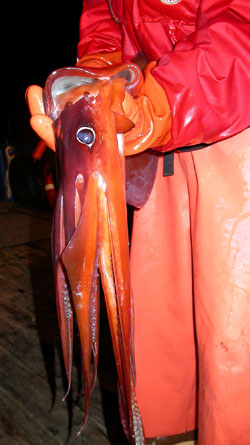Groundfish Assessment Program
Diel Sampling of Epipelagic Ichthyofauna in Offshore Waters of the Eastern Gulf of Alaska
During a research cruise in August 2005, ABL scientists conducted diel sampling of epipelagic ichthyofauna in offshore
waters of the eastern Gulf of Alaska. The general objective of the cruise was to evaluate procedures for a trawl indexing
survey for young-of-the-year (YOY) rockfish, sablefish, and salmon in offshore waters of southeastern Alaska. This research
was done under a new annual partnership agreement between ABL and the ADF&G. Three programs within ABL collaborated on this
study: Groundfish Assessment, Marine Salmon Interactions, and Ocean Carrying Capacity. The ABL scientists on the cruise were
Dave Clausen and Dean Courtney of the Groundfish Assessment Program, Joe Orsi and Alex Wertheimer of the Marine Salmon
nteractions Program, and John Pohl of the Ocean Carrying Capacity Program. Bill Floering of the NOAA Pacific Marine Environmental
Laboratory (PMEL) in Seattle also participated in the cruise.
Due to favorable weather, sampling was successfully completed at all priority stations and all cruise study objectives were met.
On the first evening of the trip, an acoustical mooring buoy was deployed in Cross Sound near Cape Spencer as part of a project
with PMEL; the buoy will measure subsurface currents at this location. During the rest of the cruise, day and night surface-trawl
sampling with a Nordic 264 rope trawl was done at nine stations. These stations were located up to 75 km offshore in southeastern
Alaska along three transects: Cape Edward, Cross Sound, and Icy Point. One station had to be moved inshore to Lisianski Strait
during the only day of poor weather that occurred.
Catches totaled nearly 40,000 fishes representing 22 species in 55 hauls. Catch in numbers for the target species of the study were
as follows: YOY rockfish, 11; YOY sablefish, 70; and salmon, 587. Catches of YOY rockfish were less than anticipated, which may be
an indication of patchy distribution or of poor survival in 2005 for YOY rockfish off southeastern Alaska. Oceanographic data were
collected coincident with the vessel track and trawl hauls to investigate the relationship between oceanographic conditions and the
distribution and abundance of fish caught in the trawl. These data included continuous measurements by a thermosalinograph of surface
temperature and salinity, and conductivity-temperature-depth (CTD) casts to depths of 200 m at 31 hauls. Information from this study will
provide a conceptual framework of diel interactions among species and enable scientists to better understand marine ecosystem dynamics.
| |

Figure 3. Humboldt squid (Dosidicus gigas) caught offshore Cape Spencer in southeastern Alaska by the
research vessel Medeia in August 2005.
|
Several unusual non-target species were captured during the cruise, including Pacific pomfret, Pacific sardine, blue shark, and
Humboldt squid (Dosidicus gigas) (Fig. 3). Occurrence of these species may be related to above average surface temperatures that were
observed for 2005 in the eastern Gulf of Alaska. Although occasional Pacific pomfret are sometimes observed during the summer in the
Gulf of Alaska, Pacific pomfret was the most abundant fish species caught in terms of weight for this cruise. Pacific sardine have
become much more abundant in recent years in waters off the U.S. West Coast and British Columbia, and they appear to have expanded
their range into southeastern Alaska in the last few years. We caught Pacific sardines in nearly one-third of the trawl hauls,
indicating the widespread occurrence of this species in the area that was sampled. A total of six blue sharks were caught in the cruise,
which suggests that blue sharks may have been unusually abundant in the study area.
Finally, we caught a total of 29 Humboldt squid, including one haul that captured 20 individuals. This large squid normally does not
range north of Baja California Mexico, and until last year had never been found north of Newport, Oregon. In 2004, it appeared off
Washington State, British Columbia, and southeastern Alaska as far north as Sitka. The Humboldt squid that were caught in this cruise
are the most northerly specimens that have been collected.
By Dave Clausen and Joe Orsi
>>>continued
 |

|
JAS2005 quarterly sidebar
AFSC Quarterly
Research Reports July-Sept 2005
Contents
Feature
ABL Reports
FMA Reports
NMML Reports
RACE Reports
REFM Reports
Items
Quarterly Index
Quarterly Home
|

